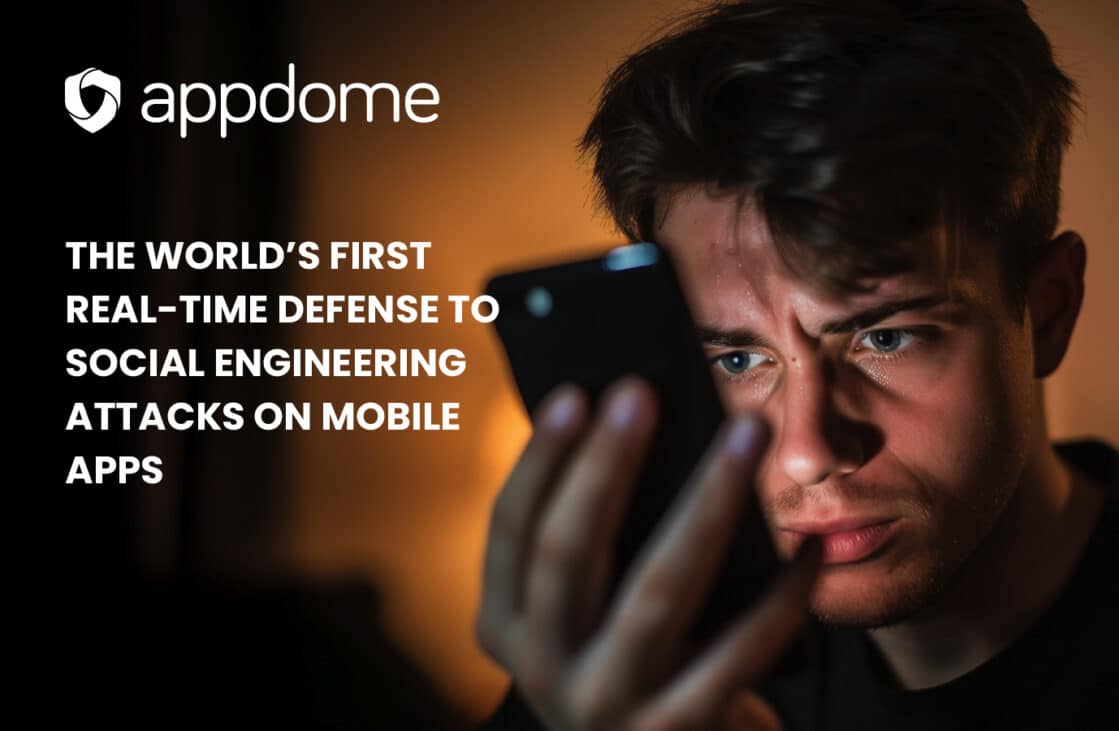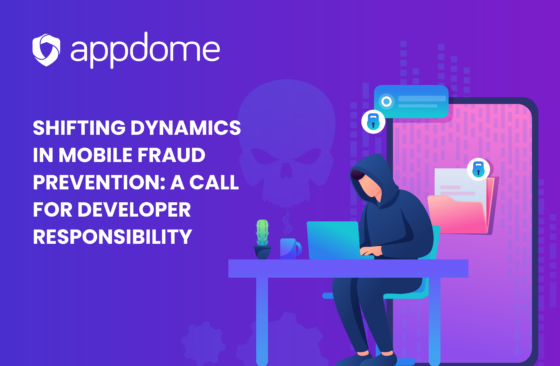Drumroll please, Appdome just announced the world’s first real-time defense against Social Engineering attacks targeting mobile apps and consumers.
Breaking the Cycle of AI-Powered Social Engineering Attacks
In an increasingly digitized world where mobile apps play a central role, the specter of social engineering attacks casts a long shadow over cybersecurity efforts. In fact 98% of cyber attacks begin with social engineering tactics, contributing to social engineering’s epic ascension to become a multi-billion dollar industry for fraudsters, a business that plagues users, brands, and developers alike.
Mobile: The New Frontier of Social Engineering
Mobile applications have become a breeding ground for social engineering attacks, presenting new challenges for both users and mobile developers. The convenience and ubiquity of mobile devices make them prime targets for attackers seeking to exploit user trust and capitalize on human vulnerability. The prevalence of AI-powered social engineering attacks underscores the need for proactive measures to safeguard sensitive data and protect users from harm. Look no further than this Time Magazine article where they call out major mobile banking brands for not doing enough to prevent the social engineering epidemic.
Social Engineering Attacks Are Deeply Personal, Abuse and Exploitative
Social engineering attacks are deeply personal and use psychological manipulation of human emotions, which is why anyone, even tech-savvy individuals, can become a victim. Social engineering attacks exploit brand trust, tricking mobile users into revealing sensitive personal information or tricking the victim into taking actions in a mobile app that the attacker can abuse, such as baiting the user to unknowingly install malware and remote access trojans under the guise of a “security fix”. As highlighted in this dark reading article, perpetrators of social engineering attacks are ruthless criminals, and they use a myriad of techniques, methods and tools to deceive users. Successful social engineering attacks can have far-reaching consequences for consumers, including account takeover, financial loss, identity theft, confusion, shame and fear. They exploit the trust of users to gain unauthorized access to sensitive information or manipulate user behavior. These attacks pose significant risks to both users and brands as well and can cause lasting brand damage. Traditionally, detecting and stopping these attacks has been very difficult, and mitigating such attacks has been a reactive process, leaving brands and users exposed to prolonged harm.

The Disaster Scenario No Brand Wants
Consider the following scenario, which is quite typical of a social engineering attack. Grandma was shopping in her favorite mobile retail app, she gets a call from a malicious person masquerading as an employee of the mobile shopping app, who tells Grandma they noticed she was having some trouble with her shopping cart. They ask her to download an ‘upgraded’ version of the app, it looks like the real app, but it’s actually a fake/clone, with hidden remote access Trojan (RAT) malware inside. The Trojan abuses accessibility services, and also tricks grandma into approving a bunch of dangerous permissions, each of which the malware exploits to its advantage, all of which ultimately allows the fake employee to take control of grandma’s device, lock her out of her apps/account, and steal her credit card info and her loyalty points. Grandma is visibly shaken and upset, she quits using the app altogether and tells all her friends. Her painful story made the news. The damage to the mobile brand was huge, cost of cleanup was high, customer transactions fell, share price fell…No mobile app brand wants this scenario to happen to them.
Breaking the Blame Cycle
But where can brands turn? Existing solutions around social engineering tend to place the burden of prevention solely on the user, urging them to exercise caution and vigilance. However, the days of assuming mobile users can protect themselves are long over. The sophistication of modern malware and the deceptively convincing nature of modern social engineering renders even the most vigilant users susceptible to deception.
Appdome Introduces the First Ever Real-Time Social Engineering Defense
Appdome has introduced a groundbreaking social engineering prevention solution that enables mobile developers and brands to solve this problem proactively with in-app defenses that they can build into Android and iOS apps using Appdome’s automated unified mobile app defense platform. Appdome’s Social Engineering Prevention solution is designed to break the cycle of social engineering by providing real-time defense against a broad range of social engineering tactics. By continuously detecting, blocking, and intervening in potential attacks, mobile brands can protect billions of users across Android and iOS platforms from fraud and abuse.
So what exactly do we mean by “breaking the cycle” of social engineering? When an attacker makes contact with a mobile app user, nothing is standing between the attacker and the user. The more convincing the attacker, the more likely the user is to fall for the scam. Appdome’s solution fills this void. Appdome uses technology to break the cycle, ie: to intervene while the attack is in progress, providing the right information at the right time, to prevent the user from giving the attacker what they want.
Appdome’s Social Engineering Prevention solution includes the following innovative new defenses.
Appdome’s Social Engineering Prevention Features
• Voice Phishing (Vishing) Fraud Detection: Utilizes behavioral analysis to identify suspicious activity coinciding with potentially malicious phone calls, while the app is being used. This feature detects and prevents voice phishing attacks (aka vishing), where attackers use phone calls to deceive users into disclosing sensitive information or performing unauthorized actions.
• Remote Desktop Control Detection: Identifies third-party applications used in social engineering attacks to remotely take control of mobile devices and applications maliciously. By monitoring for unauthorized remote access attempts, this feature prevents attackers from gaining control over users’ devices and executing malicious actions.
• Facial Recognition Bypass Detection: Prevents attackers from circumventing biometric security measures (such as FaceID) and gaining unauthorized access to users’ accounts or sensitive information.
• SIM Swapping Detection: Detects and prevents SIM swapping attacks, where attackers fraudulently transfer a legitimate user’s phone numbers to a SIM card or eSIM under the attacker’s control, which may allow MFA bypass, creating fraudulent accounts, conducting account takeovers, and even identity theft.
• Admin-SU Profiles Detection: Identifies the presence of management profiles (MDM profiles) installed on devices, which compromise user privacy and may allow attackers to take control of user devices and accounts.
• Trojan/Fake App Prevention: Prevents mobile users from unknowingly installing malicious apps (Trojans, malware, etc) that can compromise their devices and steal sensitive information.
Appdome Breaks the Cycle of Social Engineering Attacks As They Occur
Now remember the Grandma attack scenario that I talked about earlier? Here’s what that scenario would look like with an Appdome-protected app. Grandma was shopping in her favorite mobile retail app, when she gets a call from a malicious person masquerading as an employee of the mobile shopping app, The mobile shopping app delivers an in-app push notification to Grandma that says “Are you ok? We detected an unusual event ” to break the user out of that emotional duress pressure cycle and alert her to the fact that she was talking to an imposter. She stopped the call and went back to mobile shopping. The attack was instantly stopped in real time, with no loss for Grandma or the mobile brand. Grandma tells all her friends about the weird call and how the mobile brand protected her, said the mobile brand was her favorite and her confidence went way up. Her friends shared the story and shopped even more using mobile brand.
Appdome Unified Mobile App Defense, Automated in DevOps Pipelines
Appdome’s Social Engineering Prevention solution is available from the same unified mobile app defense platform that our customers use to rapidly implement over 300+ mobile app defense features into any Android & iOS app in minutes – fully automated no coding, no SDK, no servers, and no work for the dev team. This allows our customers to add social engineering prevention features combined with any of our mobile app security, anti-fraud, anti-malware, anti-bot, geo compliance features, as well as real-time threat and attack detection. The power of automation makes all this possible, without any impact to the existing development and delivery process used by the dev team to build and release apps. No additional resources, no additional time, no complex SDKs to implement, and no siloed solutions that conflict with other services in the app! Everyone wins.
Moreover, Appdome provides multiple enforcement modes, allowing brands to customize their response to threats. Whether it’s in-app defense, detection, or leveraging Appdome’s Threat-Events™ framework for user experience control, brands have the flexibility to intervene effectively and protect their users.
In a landscape where mobile app security is of paramount importance, Appdome’s Social Engineering Prevention solution empowers brands to stay one step ahead of attackers. By leveraging real-time detection and intervention capabilities, brands can safeguard user trust, protect their reputation, and ensure business continuity.
As the mobile app ecosystem continues to evolve, Appdome remains committed to its mission of protecting every mobile app in the world and the people who use them. Preventing social engineering is in everyone’s best interest, except for fraudsters of course. We at Appdome are both proud and grateful to have the opportunity to solve such an important problem. Interested in seeing Appdome’s social engineering prevention solution in action?
Click the button below to get a free demo.
Request a Demo






